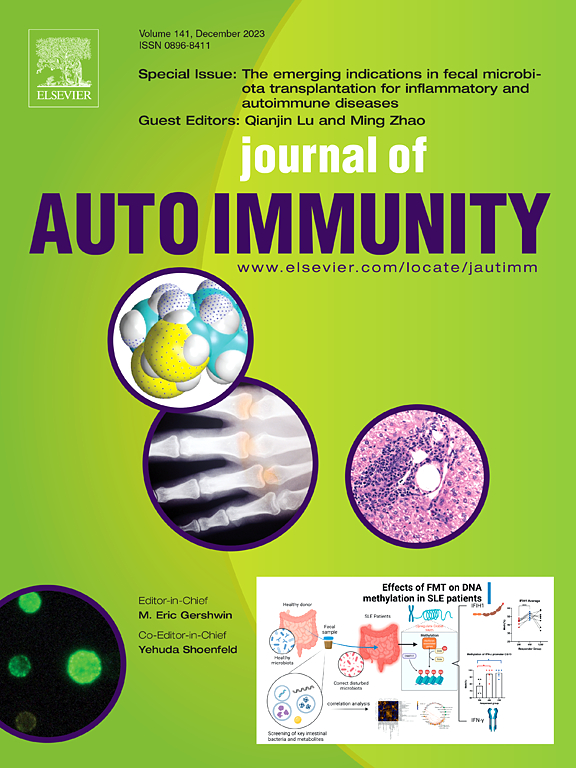秋水仙碱和抗il -1阻滞剂治疗FMF的长期疗效和安全性:来自欧洲热多中心观察研究的结果
IF 7
1区 医学
Q1 IMMUNOLOGY
引用次数: 0
摘要
目前可获得的关于家族性地中海热(FMF)的大部分数据来自回顾性的国家或国际研究。方法一项观察性研究收集了欧洲热国际FMF队列的数据。满足遗传和临床欧洲热标准的患者被认为是FMF+。不符合临床和/或遗传(一个VUS或良性变异或MEFV变异阴性)标准的患者被认为是FMF-。对治疗依从性和生活质量的数据也进行了记录。结果自2024年11月至今,共纳入FMF患者876例(466例M, 410例F),平均随访2.9±3.1年。FMF+组730例(84%),FMF-组146例(16%),两组患者临床表现及治疗反应的患病率差异有统计学意义。最后一次随访时,433例(50.6%)患者仍有一些疾病活动。在最后一次随访中,749例(85.5%)患者服用了秋水仙碱,但剂量相对不足。133例患者(15.2%)接受了抗il -1治疗,主要是canakinumab(117例,13.4%)。治疗依从性一般令人满意,不良事件一般轻微。结论缺乏基因证实的fmf样表型患者在临床特征和发作时间上存在显著差异,在病程中对治疗反应较差,应考虑为fmf样表型患者,并调查其他原因。纵向数据对FMF的长期负担以及治疗对疾病活动和患者生活质量的影响提供了更详细的理解。本文章由计算机程序翻译,如有差异,请以英文原文为准。
Long-term efficacy and safety of colchicine and anti-IL-1 blockers in FMF: results from the Eurofever multicenter observational study
Introduction
The majority of currently available data on familial Mediterranean fever (FMF) come from retrospective national or international studies.
Methods
An observational study collected data on the Eurofever international FMF cohort. Patients fulfilling genetic and clinical Eurofever criteria were considered as FMF+. Patients not fulfilling clinical and/or genetic (one VUS or benign variants or negative for MEFV variants) criteria were considered as FMF-. Data on compliance to treatment and quality of life were also recorded.
Results
Since November 2024, 876 FMF patients (466 M, 410 F) were enrolled, with a mean follow-up of 2.9 ± 3.1 years. 730 (84 %) patients were classified as FMF+, 146 (16 %) as FMF-, with significant differences in the prevalence of clinical manifestations and treatment response between the two groups. At the last follow-up, 433 patients (50.6 %) still had some disease activity. At the last follow-up 749 (85.5 %) patients received colchicine with a relative under dosage of the drug. Anti-IL-1 treatment was reported in 133 patients (15.2 %), mostly canakinumab (117, 13.4 %). Treatment compliance was generally satisfactory, and adverse events were generally mild.
Conclusions
Patients with an FMF-like phenotype who lack genetic confirmation display significant differences in clinical features and duration of attacks and show a less response to treatment during their disease course in respect, and thus, should be considered as FMF-mimics and investigated for other causes. Longitudinal data provides a more detailed comprehension of the long-term burden of FMF and the impact of treatment on disease activity and patients' quality of life.
求助全文
通过发布文献求助,成功后即可免费获取论文全文。
去求助
来源期刊

Journal of autoimmunity
医学-免疫学
CiteScore
27.90
自引率
1.60%
发文量
117
审稿时长
17 days
期刊介绍:
The Journal of Autoimmunity serves as the primary publication for research on various facets of autoimmunity. These include topics such as the mechanism of self-recognition, regulation of autoimmune responses, experimental autoimmune diseases, diagnostic tests for autoantibodies, as well as the epidemiology, pathophysiology, and treatment of autoimmune diseases. While the journal covers a wide range of subjects, it emphasizes papers exploring the genetic, molecular biology, and cellular aspects of the field.
The Journal of Translational Autoimmunity, on the other hand, is a subsidiary journal of the Journal of Autoimmunity. It focuses specifically on translating scientific discoveries in autoimmunity into clinical applications and practical solutions. By highlighting research that bridges the gap between basic science and clinical practice, the Journal of Translational Autoimmunity aims to advance the understanding and treatment of autoimmune diseases.
 求助内容:
求助内容: 应助结果提醒方式:
应助结果提醒方式:


